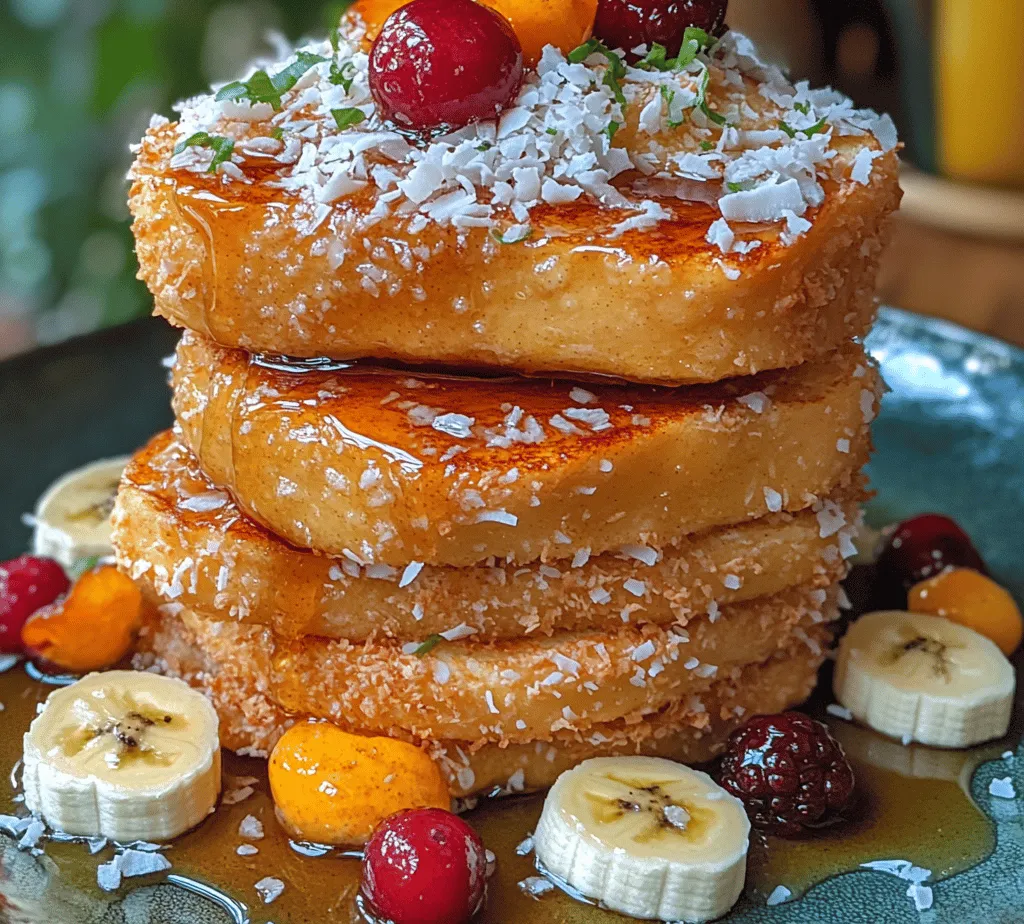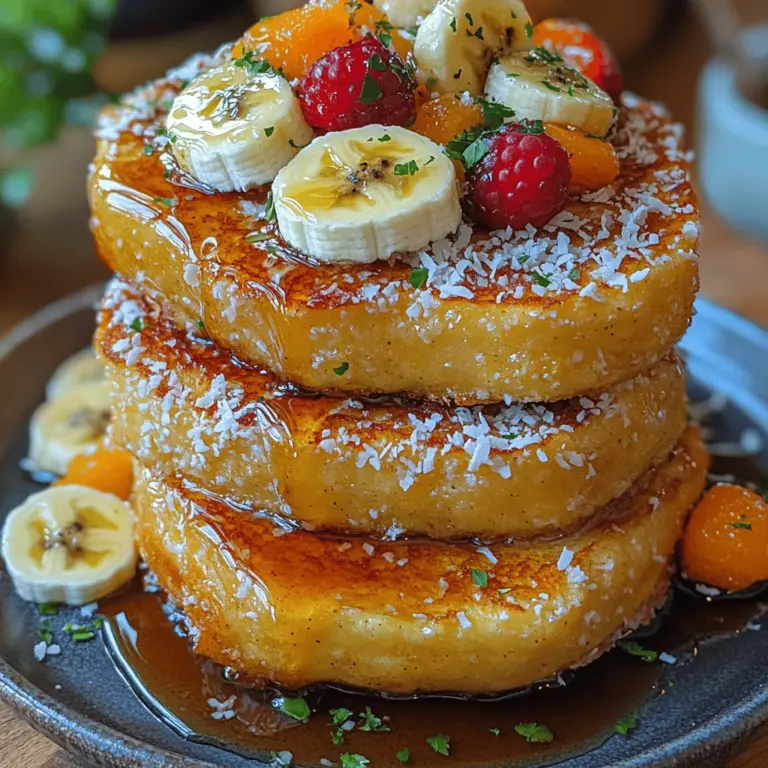Introduction
The allure of a delicious breakfast can set the tone for a wonderful day, and few dishes are as comforting and delightful as French toast. This Coconut Crusted French Toast recipe elevates the classic dish with the tropical flavor of coconut, making it a perfect choice for brunch gatherings or a cozy weekend breakfast at home. With a crispy coconut crust and a fluffy interior, this dish is not only easy to prepare but also visually appealing and flavorful.
French toast has long been a beloved breakfast staple, and its versatility allows for countless variations. From classic cinnamon-sugar toppings to extravagant berry compotes, the possibilities are endless. However, this Coconut Crusted French Toast takes it a step further by incorporating a delightful crunch and a hint of tropical sweetness. Imagine sinking your fork into a slice of golden-brown French toast, where the delightful crisp of toasted coconut meets the soft, custardy center. Each bite transports you to a sunny beach, making it an ideal treat for those looking to bring a touch of paradise to their breakfast table.
In this post, we will explore the ingredients, preparation methods, and serving suggestions for this delightful recipe, ensuring you can recreate this tropical breakfast experience in your own kitchen.
Understanding the Ingredients
Before diving into the recipe, it’s essential to understand the key ingredients that contribute to the unique flavor and texture of Coconut Crusted French Toast.
The Bread: Choosing the Right Base
The foundation of any French toast is the bread, and selecting the right type is crucial for achieving the desired texture and flavor. For this Coconut Crusted French Toast, using thick slices of bread is essential. Thick bread not only holds up well to the custard mixture but also helps create a satisfying bite.
Recommendations: Challah vs. Brioche
Both challah and brioche are excellent choices for French toast, each offering distinct characteristics:
– Challah: This traditional Jewish bread is slightly sweet and has a light, airy texture. Its egg-rich dough makes it perfect for soaking in the custard, resulting in a fluffy interior that complements the crispy coconut crust.
– Brioche: A French bread known for its rich flavor and buttery texture, brioche takes French toast to another level of indulgence. Its dense yet soft structure absorbs the custard beautifully, ensuring that each slice is moist and flavorful.
Choosing either of these breads will enhance the overall experience of your Coconut Crusted French Toast, providing a perfect balance of flavor and texture.
Eggs and Dairy: The Custard Base
The custard base is the heart of any French toast recipe, and eggs play a pivotal role in its creation. Eggs not only bind the ingredients together but also contribute to the custard-like texture that is essential for a satisfying French toast.
Whole Milk vs. Coconut Milk: Flavor Implications
While whole milk is a classic choice for a French toast custard, using coconut milk introduces an exciting twist that complements the tropical theme. Coconut milk, with its creamy consistency and subtle sweetness, enhances the overall flavor profile of the dish. It infuses the French toast with a light coconut essence, making each bite a delightful experience.
When preparing your custard, consider the following tips to achieve the perfect mixture:
– Combine Ingredients Thoroughly: Whisk together the eggs and milk until well combined. This ensures that the mixture coats the bread evenly.
– Let it Sit: Allowing the mixture to sit for a few minutes before dipping the bread helps the flavors meld together, resulting in a richer custard.
Flavor Enhancers: Vanilla and Cinnamon
To elevate the flavor of your Coconut Crusted French Toast, don’t overlook the importance of vanilla extract and ground cinnamon. These two ingredients are transformative, adding depth and warmth to the custard mixture.
Importance of Vanilla Extract in Enhancing Flavor
Vanilla extract is a quintessential ingredient in many breakfast dishes, and it plays a significant role in enhancing the overall flavor of the French toast. A splash of pure vanilla extract adds a sweet, aromatic quality that complements the richness of the eggs and the creaminess of the milk.
Role of Ground Cinnamon in Adding Warmth
Ground cinnamon is another essential ingredient that brings warmth and a hint of spice to the dish. It pairs beautifully with the sweetness of the coconut and adds a comforting element to each bite.
When crafting your custard, striking the right balance of flavors is key. Aim for just enough vanilla and cinnamon to enrich the dish without overpowering the tropical coconut flavor.
The Coconut Crust: A Tropical Twist
The crowning glory of this dish is undoubtedly the coconut crust. The use of sweetened shredded coconut adds a delightful crunch and a burst of tropical flavor that sets this recipe apart from traditional French toast.
Benefits of Using Sweetened Shredded Coconut
Sweetened shredded coconut not only adds texture but also enhances the overall sweetness of the dish. Its toasty flavor complements the custard-soaked bread beautifully.
The Addition of Flour for Better Adhesion
To ensure that the coconut adheres well to the bread and forms a perfect crust, a bit of all-purpose flour can be mixed with the shredded coconut. This helps the coconut stick, creating a crispy coating that transforms the eating experience.
The combination of the crunchy coconut crust with the soft custardy bread is what makes Coconut Crusted French Toast such a standout dish, pleasing both the palate and the eyes.
Preparation Process
Once you have gathered all your ingredients and understood their roles, it’s time to dive into the preparation process. Follow these steps to create your Coconut Crusted French Toast.
Whisking the Egg Mixture
The first step in preparing your Coconut Crusted French Toast is to create the custard. Here’s how to do it:
1. Gather Your Ingredients: You will need eggs, your choice of milk (whole or coconut), vanilla extract, and ground cinnamon.
2. Crack the Eggs: In a large mixing bowl, crack the desired number of eggs (typically 2-4, depending on the number of servings).
3. Add the Milk: Pour in the milk of your choice, using about 1/4 cup of milk for every egg used. If you prefer a richer flavor, opt for coconut milk.
4. Incorporate Vanilla and Cinnamon: Add a teaspoon of vanilla extract and a dash of ground cinnamon to the egg mixture.
5. Whisk Thoroughly: Using a whisk, beat the ingredients together until the mixture is smooth and well combined. This is crucial for ensuring that the custard coats the bread evenly.
6. Let It Rest: Allow the mixture to sit for a few minutes. This resting time helps the flavors meld and ensures a richer custard.
Creating the Coconut Coating
While the custard mixture is resting, it’s time to prepare the coconut coating. Follow these steps:
1. Prepare the Coconut Mixture: In a shallow dish, combine sweetened shredded coconut with a couple of tablespoons of all-purpose flour. The flour will help the coconut adhere to the bread better.
2. Mix Well: Stir the coconut and flour together until they are evenly distributed.
3. Set Up Your Dipping Station: Arrange your egg mixture and coconut mixture side by side. You will also need a plate or baking sheet to hold the coated bread.
4. Dip the Bread: Take a slice of your chosen bread and dip it into the egg mixture, ensuring it is fully coated but not overly soggy.
5. Press into Coconut: Immediately transfer the egg-coated bread to the coconut mixture. Press down gently to ensure the coconut adheres well to the surface.
6. Repeat: Continue this process until all slices of bread are coated with the custard and coconut.
In the next section, we will explore the cooking process and offer tips for achieving the perfect Coconut Crusted French Toast. Stay tuned for more delicious details!

Detailed Instructions for Mixing Coconut and Flour
To create the perfect coconut crust for your French toast, start by mixing shredded coconut and flour. This combination is essential for achieving that delightful crunch and flavor. In a medium-sized bowl, combine 1 cup of unsweetened shredded coconut with 1/2 cup of all-purpose flour. If you prefer a gluten-free option, substitute the all-purpose flour with almond flour or a gluten-free flour blend.
Using a whisk, blend the coconut and flour until evenly mixed. This step is crucial because it ensures that the coconut is well-distributed throughout the flour, allowing for a consistent coating on each slice of bread. The texture of the crust will depend on how evenly you incorporate the ingredients. For an added depth of flavor, consider mixing in a pinch of salt and a teaspoon of vanilla extract to enhance the overall taste.
Dipping and Coating the Bread
Once your coconut and flour mixture is ready, it’s time to prepare the bread. Take your slices of bread (thick-cut brioche or challah works best) and dip each slice into the custard mixture you prepared earlier. Make sure the bread is fully soaked but not overly soggy; a good rule of thumb is to let the slice sit in the custard for about 30 seconds on each side.
After dipping, gently shake off any excess custard before moving to the coating station. This is where the even coating process comes into play. For the best results, press each slice into the coconut-flour mixture, ensuring that both sides are thoroughly coated. You want to apply enough pressure to adhere the coconut crust to the bread without squishing the slice. If you find that the coating isn’t sticking well, you can lightly re-dip the bread into the custard and then back into the coconut mixture for a thicker crust.
Cooking the French Toast
Now that your bread is coated and ready, it’s time to cook the French toast. Preheat a non-stick skillet or griddle over medium heat. The ideal temperature is crucial for achieving that beautiful golden-brown color without burning the coconut. If your skillet is too hot, the coconut may toast before the bread is cooked through, leading to a burnt exterior and raw center.
Add a tablespoon of butter (or your preferred cooking oil) to the skillet, allowing it to melt and coat the bottom evenly. Place the coated slices of bread on the skillet, ensuring there is enough space between them to allow for even cooking. Cook for about 3 to 4 minutes on one side, or until golden brown. Once you see a lovely color developing, flip the slices carefully using a spatula.
Cook the other side for an additional 3 to 4 minutes. If you’re using a thicker bread, you may need to adjust the cooking time slightly—lowering the heat can help the inside cook through before the outside gets too dark. Keep an eye on the French toast; if it’s browning too quickly, reduce the heat.
If you’re using different stovetops or pans, note that induction cooktops may require different heat adjustments, so it’s good to familiarize yourself with your equipment beforehand.
Serving Suggestions
Plating the French Toast
When it comes to serving your Coconut Crusted French Toast, presentation is key. Start by stacking two or three slices on a plate, slightly offsetting each slice to create an appealing layered effect. This not only looks inviting but also makes it easier for guests to serve themselves.
For a burst of color and freshness, consider adding garnishes. Fresh fruit like sliced bananas, strawberries, or a medley of berries can elevate the dish both visually and in flavor. A sprinkle of powdered sugar over the top adds a touch of sweetness and an elegant finish. If you’re feeling adventurous, you can even add a dollop of whipped cream or a scoop of yogurt on the side for extra creaminess.
The Sweet Finish: Maple Syrup
No French toast is complete without a drizzle of maple syrup, but selecting the right type can enhance your dish significantly. Opt for pure maple syrup rather than imitation syrups; the rich flavor of real maple syrup complements the coconut beautifully.
If you want to add a twist, consider infusing your maple syrup with flavors such as vanilla bean, cinnamon, or even a splash of coconut milk for a tropical touch. Alternative toppings like honey, agave nectar, or flavored syrups (like caramel or berry) can also provide unique flavor profiles to suit your taste.
Nutritional Insights
Understanding the Nutritional Profile
Coconut Crusted French Toast is not just a treat for your taste buds; it also offers some nutritional benefits. A typical serving contains approximately 250-300 calories, depending on the bread type and toppings used. The coconut adds healthy fats, while the bread provides carbohydrates for energy.
The inclusion of fresh fruit enhances the nutritional profile, adding vitamins, fiber, and antioxidants. The natural sugars in fruit can satisfy your sweet tooth without the need for excessive syrup, making this dish a more wholesome breakfast option.
Dietary Considerations
For those with dietary restrictions, this recipe can easily be adapted. To make it dairy-free, simply substitute the milk in your custard with almond milk, coconut milk, or any other plant-based milk. For a gluten-free version, as mentioned earlier, use gluten-free flour and ensure your bread is certified gluten-free.
For a healthier alternative, consider using whole grain or sprouted grain bread, which adds more fiber and nutrients compared to white bread. You can also reduce the amount of sugar in the custard mixture, as the natural sweetness of the coconut and fruit can often suffice.
Conclusion
Coconut Crusted French Toast is more than just a breakfast dish; it’s an experience that combines the comfort of classic French toast with the exotic flavor of coconut. With its easy preparation and delightful presentation, this recipe is sure to impress anyone at your breakfast table. Whether you choose to enjoy it on a leisurely weekend morning or serve it at a special brunch, this dish is destined to become a favorite in your culinary repertoire.
Enjoy the delightful flavors and textures that this unique recipe has to offer, and savor the joy of a homemade breakfast treat. Perfectly crispy on the outside and soft on the inside, this Coconut Crusted French Toast is a delightful way to start your day.

